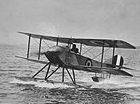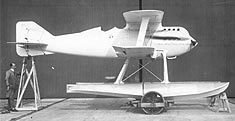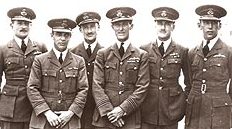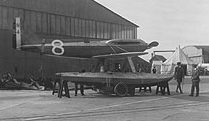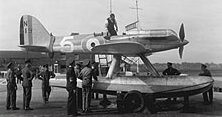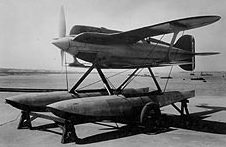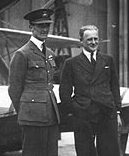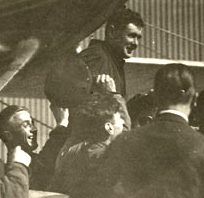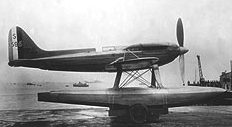|
||
|
The Early Races
The contest had a fairly low-key opening race. Held at Monaco on 16 April 191, there were only four entrants - three French and one American (although he was born in Haiti, educated in France and flying a French aircraft). The day of the contest was sunny and the water calm. The contestants were required to taxy their aircraft for half a lap before taking off to complete the remainder of the course. There was, however, time for some controversy as the winner-elect, Maurice Prévost, landed his aircraft on the water and taxied across the finish line. This was in breach of the rules and after refusing to get airborne again, the famous French pilot Roland Garros, who had dropped out with engine trouble, returned to the air to complete his race. Prévost was stung into action and eventually took off again to cross the line correctly and win the race at an average speed of 45.75mph. Ironically, no French aircraft achieved this feat in any other Schneider Trophy Race.
With the victors rested the responsibility of organising the following race, and this was again held at Monte Carlo on the 20 April 1914. The number of teams increased to five (France, Germany, Switzerland, the USA and Great Britain) and a few rules were changed. Garros and Prévost again led the French effort, but the contest was won by Howard Pixton, an Australian, flying a Sopwith Tabloid. Such was the pace of the nippy Tabloid, that in a vain attempt to make up time, two French entries seized their engines and dropped out. After completing the allotted race distance, Pixton continued for a further two laps to set a new world seaplane speed record over 300km (186.41 miles) of 86.6mph. For the race itself, the average speed was 86.78 mph (139.66km/h).
Sopwith Tabloid
The next contest was held at Bournemouth in September 1919. Teams from Great Britain, France and Italy were entered and one curious thing about all the aircraft was that they were biplanes whereas in 1914 they were monoplanes! The three British entrants were a Sopwith Schneider, Supermarine Sea Lion and Fairey III. The day of the race was foggy and the start delayed until evening. The fog caused problems for the first contestant, Vincent Nicholl in the Fairey III, who narrowly missed a boat mast and another aeroplane before he gave up. The other British racers fared no better and it was left to Sgt Janello of the Italian team to make the next attempt. The was controversy when his race times exceeded the known top speed of his aircraft. Faulty navigation had caused Janello to miss one of the race markers and he was disqualified. Fearing a major diplomatic incident, the race was finally awarded to the Italians some two weeks after the contest only for the FAI, the governing body, to strip them of the victory but award them the 'honour' of hosting the next race.
The Roaring 20sThe 1920 contest in Venice was something of a non-event. Economic difficulties in France and Great Britain meant that no entries were forthcoming from these nations and so the Italians were left to fight between themselves. The following year's race was equally shambollic as the lone French entrant experienced problems with its floats and could not participate leaving the Italians to reclaim the title unopposed. Now, under the rules of the competition, if Italy was to win the following race it would claim the trophy outright.
The 1922 race was moved to Naples and this time the Italians did have opposition in the form of a government-funded French team and a British team financed by privateer Hubert Scott-Paine. In the spirit of true competitiveness, none of the teams revealed their aircraft's true capabilities before the day of the race, 12 August, flying well below maximum performance or taking the turns very cautiously. The race itself was full of incident as the Italians bunched together and attempted to prevent Britain's Henri Biard in a Sea Lion II from passing them. To counter this, Biard simply opened the throttle to full and flew over the top of his opponents before slowing down to preserve his engine. As the race neared its completion, the closest Italian aircraft, a Savoia S51, which had previously capsized prior to the race and been recovered, encountered problems when the laminating holding the engine on to the aircraft became separated due to its dunking and was forced to retire. This left Biard to win for Britain and keep the contest alive.
The Royal Aero Club chose Cowes on the Isle of Wight as venue for 1923 race and the British, French and Italians were joined by the Americans, flying, for the first time, American-built aircraft - the Curtiss CR3 and Wright NW2 racers. Problems with a second British aircraft, the Blackburn Pellet, meant that the team was reduced to a single aircraft, the Sea Lion III again piloted by Henri Biard. The French again suffered appalling luck - one aircraft struck a yacht whilst taxying to the start and the second and third were withdrawn when their engines failed. Biard tried valiantly to catch the sleek, American machines but the race was comfortably won by Lt David Rittenhouse in a Curtiss CR3 at an average speed of 177.374 mph (285.44 km/h).
No sooner had the Americans won the Schneider Trophy for the first time than preparations for the 1924 race began with Curtiss and Wright working on new designs for the race. France announced its withdrawal and the Italians followed after abandoning its only suitable project due to a lack of engine. The British team also withdrew when the one of the two aircraft ordered for the contest, the Gloster II, crashed during trials and the second was not completed in time. In a true act of sportsmanship, the Americans declined the opportunity to claim the victory by carrying out a fly-over and postponed the event.
Gloster IVA
The build up for the 1925 race in Chesapeake Bay, Baltimore was marred by an accident to one of one of the great racers - Henri Biard. Having broken his hand on the voyage across the Atlantic, Biard then caught flu. Having decided to take his aircraft, a Supermarine S4, up for a test flight, Biard lost control of the aircraft and stalled. Luckily he was pulled from he wreckage but the cause of the mishap was never discovered. A further accident to one of the remaining British entrants, a Gloster IIIA, left Hubert Broad in the sole surviving Gloster IIIA and the Italians to battle the American team led by a then little-known US Army test pilot called James Doolittle for the trophy. Doolittle flew perfectly to beat Broad and the Italian entry comfortably and the US team retained the cup for a further year.
The 1926 race meant that another win for the Americans would see them win the Trophy outright. The British, wishing to develop very advanced racers from Supermarine and Gloster to beat the hosts, asked for the next race to be delayed until 1927 to allow them time to build their aircraft, but this was politely refused. It was a very different story in Italy. The new Fascist leader, Benito Mussolini, promised that all the financial and material assistance required by Macchi and Fiat to enable them to produce an aircraft capable of beating the Americans would be provided. The hosts entered and updated version of the RC3 and a new Curtiss design, the F6C-3 Hawk with the US Navy providing the pilots. The race itself saw some very exciting flying with the two teams racing neck-and-neck to the finish with the Italians finally coming out on top to win and bring the Trophy back across the Atlantic.
The 1929 RaceThe victory ensured that the next race would be held over British water, the location again being Cowes. This was not to be until 1929, as the various participants and the FAI agreed that the increasing costs and technological advances were prohibitive to an annual event.
Following its 1927 victory, the High Speed Flight had been disbanded and it was expected that no Treasury money would be made available to finance a British team for the 1929 meeting. This did not happen, but the Air Ministry objected to the use of its pilots, but agreed to supply the aircraft. That said, the High Speed Flight reformed in February 1928 and the following month an attempt on the world speed record would be made by Flt Lt S Kinkhead in one of the S5s. During the attempt, Kinkhead plunged into the sea during the steep approach to the start of the course and was killed. He was replaced by Flt Lt D D'Arcy A Greig who was joined by Flt Lt GH Stainforth, Fg Offs RLR Atcherley and HRD Waghorn. Flight Commander was Sqn Ldr AH Orlebar.
British Schneider Team
Air Ministry funded was not forthcoming for new engines and so Rolls Royce financed the building of a military engine with 'racing capabilities'. Whilst the engine was still a paper design, RJ Mitchell of the Supermarine Company began work on the S6 aircraft which would be used by the British team. The basis of the design was the successful S5 airframe and two S6s were ordered. The designers at Glosters were not idle and soon their next design, the Gloster V biplane racer, was taking shape. This eventually saw the light of day as a monoplane and was designated the Gloster VI. Two of these were ordered at a cost of £25,000. The design was fated never to compete in the race. During trials, many unexplained failures of its Napier Lion engine occurred and the type withdrawn.
The only challengers to make the race meeting were Italy who brought a further development of the M52 airframe, the M52R, and a new aircraft, the Macchi M67. It had been intended that France would compete after a six-year absence but the two designs chosen for the 1929 race were not completed in time and the team withdrew. As for the Americans, it was a familiar tale. The government still refused to support an entry for the Schneider Trophy and left any finances to be raised privately. This did happen, but the intended aircraft, the Kirkham-Williams Mercury, which was to have been powered by a secretly-built US Navy engine, was barely capable of sustained flight and again the US did not attend. Neither did the Germans who had hoped to race, but their Dornier project never got off the drawing board.
Supermarine S6
On the eve of the race a small piece of metal was found in the engines of one of the S6s and after further investigation it was found that one of the pistons was damaged necessitating a cylinder block change. A sweep of the local hostelries and pubs raised enough Rolls Royce engineers to carry out the task, and after a full night's work and ground running, the aircraft was ready at 0800 on the day of the race.
The race weather was perfect and the first aircraft airborne was the S6 of Flt Lt Waghorn. The aircraft performed beautifully until Waghorn reached the sixth lap the engine began to misfire forcing the pilot to climb in the hope that should it fail completely, he could glide to the end. The engine duly failed, but Waghorn had insufficient height to carry out his plan and landed on the water short of the finish, cursing his luck. When he sighted his engineers approaching the becalmed aircraft, he noticed that they had broad smiles on their faces - having miscounted his laps, he had, as Webster had at the previous meeting, flown one extra lap. It was on this lap that the engine had failed.
D'Arcy Greig in the sole S5 and Warrant Officer Dal Molin of Italy in the M52R were caught up in a furious battle in the skies above, both at full chat in the event that Waghorn had failed to complete the distance. The remaining pilots and aircraft suffered a variety of problems. 'Batchy' Atcherley in the second S6 lost his goggles in the slipstream and flew the remainder of his race crouched inside the cramped cockpit, but was disqualified after misjudging a turn and going inside a pylon. The final realistic challenge to Waghorn's time ended when a coolant pipe broke on the second Macchi M67, scalding its pilot who successfully landed his aircraft before being taken to hospital for treatment.
Flt Lt Waghorn's average speed of 328.63 mph (528.77 km/h) was some 44mph (71 km/h) faster than second-placed Dal Mollin in the M52R who just edged D'Arcy Greig into third by barely 2mph.
The win set up, for the third time, the chance for a team to win the Schneider Trophy outright. As no less a person than Prime Minister Ramsey MacDonald commented, "We are going to do our level best to win again."
Supermarine S5
1931 - The Build-up
Political bickering and outright opposition to the RAF's involvement in the races hindered the build up to the 1931 race, which was again to be held at Cowes. Within weeks, the Cabinet had vetoed the Service's participation and withdrwn financial backing, leaving industry to finance and organise the event. The government was not very happy about continuing to support a national team, stating this 'was not in accordance with the spirit of a sporting event' which might 'not inconceivably lead to diplomatic incidents.' This decision angered the public, especially after Ramsey MacDonald's proclamation in 1929. In a Cabinet memo written after the 1929 contest, it was stated that the cost of participating in the 1927 and 1929 meetings was £196,000 and £220,000 respectively.
The Air Ministry also objected to the use of its pilots, fearing that any publicity given to the team members would not benefit Service morale. Also against the RAF's participation was Marshal of the Royal Air Force, Sir Hugh Trenchard. In his view he could see 'nothing of value in it', expressing the opinion that high speed aircraft would nevertheless be developed without the added distraction and cost of the Schneider Trophy.
At this point, a wealthy benefactor came to the aid of the Royal Aero Club. Lady Lucy Houston, who had inherited her shipping magnate husband's £6m fortune in the 1920s offered to pay £100,000 towards the cost of ensuring British participation at the all important 1931 race. The government then announced, in the way that government's do, that the RAF would be allowed to defend the Trophy with Lady Houston's backing.
Such had been the length of time that the affair had been allowed to drag on that only 9 months were left for the effort to be planned. This meant that Supermarine and Rolls Royce only had time to refine the existing S6 airframes and R-Type engines if they were to be ready in time. The R-Type's power was increased by 400hp to 2,300hp. RJ Mitchell undertook strengthening work on the S6's rear fuselage and floats. Two of these modified aircraft were ordered as the S6B, and the existing S6 aircraft were brought up to the same standard and designated as S6As.
Macchi M39
Over in Italy, Macchi were hard at work on a development of the M67, the M72. Its Fiat-built engine was 11 feet long, had 24 cylinders, a capacity of over 50,000 cc and rated at 2,850hp. This was connected to counter-rotating propellers - a remarkable feature for the time. As with the previous race, one of the Italian team was killed in test flying, but the engine was also proving troublesome and the Italian team was forced to withdraw.
France, having missed the 1929 race, was intending to make the forthcoming meeting, but again, a lack of materials, engines and the deaths of two test pilots forced their withdrawal. Germany's planned design again failed to materialise into a real aircraft and so it was left to the British to 'defend' the Trophy against no opposition. This failed to deter the British public who turned out in their thousands to see the RAF's hoped for victory. This would be achieved if just one of the aircraft, 2 S6Bs and a single S6A, flew the complete race distance.
The planned sequence of attempts was as follows; the first S6B, piloted by Flt Lt John Boothman would attempt to improve on the winning time set by Flt Lt Waghorn in 1929. In the event of this failing then Flt Lt Freddy Long in one of the S6As would take to the air followed, if needed, by Fg Off Leonard Snaith in the second S6B. Should either of the first two runs be successful, then an attempt on the overall world speed record would be made by the first S6B, this time piloted by Flt Lt George Stainforth. Only he and Sqn Ldr Orlebar had remained on the Flight after the previous meeting.
1931 - Squadron Leader Orlebar's Report (extract)
It was a pity that 12th September which had been fixed for the contest should have produced such bad weather particularly at the end of the finest week we had had, but it was a mercy that if it could not be fit it should be absolutely hopeless. On the next day, when no one mentioned the date though some of us realised it, we were lucky and Boothman flew over very steadily at an average speed of 340.08mph. You could see from the [viewing] pontoon that he was flying exactly according to program and it was a very good show to beat the 1929 speed by twelve miles per hour in a machine that had had to go through the gruelling new preliminary trials [each aircraft had to take-off and land fully loaded prior to commencing its run] and on a programme that allowed a wide margin of safety.
Squadron Ldr Orlebar
Those of us who had also been on the pontoons in 1929 found the suspense much greater this year. There was no bustle and excitement this time in watching other competitors starting and preparing our own later ones. And, besides, there was the uncomfortable fear of the open water between West Wittering and the Isle of Wight where a swell from the previous day was still running enough to be a possible menace for a forced landing. Still it was good to see Boothman making the machine do in every detail what we had agreed in our long discussions she ought to do. Except for having sometimes to avoid bad bumps over Southsea he flew each lap consistently on the track we had drawn out though of course he did quite rightly not to force her back on to it too quickly and so was of it for some distance. Indeed he flew worthily of the other fellows who would have flown with him against foreign competition, and I am sure he would want no higher praise. The opinion has been expressed that the turns were not so good as in 1929 but perhaps that impression came from their being less spectacular. In this case as so often happens efficiency is not spectacular.
When Boothman landed, N248 [the S6A] (Snaith) and S1596 [the second S6B] (Long) were still standing by ready to race if necessary but of course they were not needed, and we set about lightening the petrol load of S1596 for Stainforth's first attempt on the speed record. He got 379mph [609.82 km/h] but this record had to done quickly without any change of propeller from the standard for the race. The same conditions had applied in 1929 and though the advance on that year's speed was considerable we hoped for more. There had been no time for practice or working out any details more than very roughly, with the result that Stainforth had to make his approaches to the course a long way outside it to be sure of not being disqualified for diving on to the course. He therefore arrived at the most comfortable height allowed on the course well away from it and had either to flatten out there and lose the benefit of the dive or else continue the dive as close possible and fly uncomfortably low on it. Being George of course he chose the latter and as a result was sometimes forced to climb a little whilst on the course.
S6A pilot - Boothman
Thereafter up to the end of September, bad weather, the changing of engines and difficulties in completing absolutely successful engine tests for the higher power at Derby [the Rolls Royce factory] prevented any flying except a propeller test with a standard engine, which ended in S1596 turning over at low speed after landing. Stainforth had been wearing big shoes and his right heel had jammed between the rudder bar and the foot rest when applying full control to stop a swing on the valve. He was unhurt except for a small cut on the nose, and the machine, after floating for some time, sank, but was brought up again next day by divers from Portsmouth.
This accident did not hold up the final attempt as S1595, an identical machine, was available to take the higher powered engine and propeller re-twisted to suit it, but it was a difficult time because he spur of preparing for a fixed date had gone and the promised land of leave for serving personnel and of paying production work for the firms was well in sight.
On 29th September all was ready for the first flight with the 2,600hp Rolls-Royce and in case all was well we had the official observers down and the timekeepers at their posts. Everything went better even than we had hoped. Stainforth after doing a short level run to see all was as it should be went straight away for the record. This time George might have been his automatic namesake. He made no mistake in his approaches and hit off the mark boats dead every time. There is no doubt that our marvellous machine and wonderful engine could have done no better than his average of 407.5mph [655.67 km/h], and it seems unlikely any better speed will be put up for some time.
Supermarine S6b
This was the end of a party that on the whole was very good indeed and by the end of the week the High Speed Flight had closed down at Calshot. All high speed machines [including the Gloster VIs still used for training] went back to the works, hack machines to Felixstowe and the personnel on leave. These notes were started then and by the middle of the following week they had to be finished and so I beg to be forgiven for their extreme sketchiness.
There has been no time even if I had the power to do it properly to describe the splendid work of our individual inspectors, engineers and mechanics, the cheery co-operation and skill of the firms' experts attached to us or the great help of officials directly and indirectly concerned with us. I have not attempted to describe the details of construction of the machines and engines but have written simply from the point of view of a pilot of the Flight. It only remains, therefore, for me to express our deep gratitude to Lady Houston for providing the means and the powers that be for permitting us personally to carry out such absorbing and thrilling work.
If
you are interested in float planes, visit the
AVIATION A - Z
A taste for adventure capitalists
Solar Cola - a healthier alternative
|
||
|
